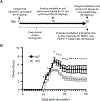Selenoprotein I deficiency in T cells promotes differentiation into tolerant phenotypes while decreasing Th17 pathology
- PMID: 35916034
- PMCID: PMC9701159
- DOI: 10.1002/JLB.1A0122-080R
Selenoprotein I deficiency in T cells promotes differentiation into tolerant phenotypes while decreasing Th17 pathology
Abstract
Selenoprotein I (SELENOI) is an ethanolamine phospholipid transferase contributing to cellular metabolism and the synthesis of glycosylphosphatidylinositol (GPI) anchors. SELENOI knockout (KO) in T cells has been shown to impair metabolic reprogramming during T cell activation and reduce GPI-anchored Thy-1 levels, which are both crucial for Th17 differentiation. This suggests SELENOI may be important for Th17 differentiation, and we found that SELENOI was indeed up-regulated early during the activation of naïve CD4+ T cells in Th17 conditions. SELENOI KO reduced RORγt mRNA levels by decreasing SOX5 and STAT3 binding to promoter and enhancer regions in the RORC gene encoding this master regulator of Th17 cell differentiation. Differentiation of naïve CD4+ T cells into inflammatory versus tolerogenic Th cell subsets was analyzed and results showed that SELENOI deficiency skewed differentiation away from pathogenic Th17 cells (RORγt+ and IL-17A+ ) while promoting tolerogenic phenotypes (Foxp3+ and IL-10+ ). Wild-type and T cell-specific SELENOI KO mice were subjected to experimental autoimmune encephalitis (EAE), with KO mice exhibiting diminished clinical symptoms, reduced CNS pathology and decreased T cell infiltration. Flow cytometry showed that SELENOI T cell KO mice exhibited lower CD4+ RORγt+ and CD4+ IL-17A+ T cells and higher CD4+ CD25+ FoxP3+ T cells in CNS tissues of mice subjected to EAE. Thus, the metabolic enzyme SELENOI is up-regulated to promote RORγt transcription that drives Th17 differentiation, and SELENOI deficiency shifts differentiation toward tolerogenic phenotypes while protecting against pathogenic Th17 responses.
Keywords: autoimmunity; ethanolamine phospholipid transferase; inflammation; metabolism; phosphatidylethanolamine.
©2022 Society for Leukocyte Biology.
Conflict of interest statement
Conflict-of-Interest Disclosure
The authors declare no conflict of interests.
Figures








Similar articles
-
Upregulated ethanolamine phospholipid synthesis via selenoprotein I is required for effective metabolic reprogramming during T cell activation.Mol Metab. 2021 May;47:101170. doi: 10.1016/j.molmet.2021.101170. Epub 2021 Jan 20. Mol Metab. 2021. PMID: 33484950 Free PMC article.
-
MAP kinase inhibitor PD98059 regulates Th1, Th9, Th17, and natural T regulatory cells in an experimental autoimmune encephalomyelitis mouse model of multiple sclerosis.Eur J Pharmacol. 2023 Nov 15;959:176086. doi: 10.1016/j.ejphar.2023.176086. Epub 2023 Oct 11. Eur J Pharmacol. 2023. PMID: 37832863
-
Increased CD4+CD45RA-FoxP3low cells alter the balance between Treg and Th17 cells in colitis mice.World J Gastroenterol. 2016 Nov 14;22(42):9356-9367. doi: 10.3748/wjg.v22.i42.9356. World J Gastroenterol. 2016. PMID: 27895423 Free PMC article.
-
S3I-201, a selective stat3 inhibitor, ameliorates clinical symptoms in a mouse model of experimental autoimmune encephalomyelitis through the regulation of multiple intracellular signalling in Th1, Th17, and treg cells.Mult Scler Relat Disord. 2023 May;73:104658. doi: 10.1016/j.msard.2023.104658. Epub 2023 Mar 23. Mult Scler Relat Disord. 2023. PMID: 36989705
-
Roles for Selenoprotein I and Ethanolamine Phospholipid Synthesis in T Cell Activation.Int J Mol Sci. 2021 Oct 16;22(20):11174. doi: 10.3390/ijms222011174. Int J Mol Sci. 2021. PMID: 34681834 Free PMC article. Review.
Cited by
-
METTL3 mediates SOX5 m6A methylation in bronchial epithelial cells to attenuate Th2 cell differentiation in T2 asthma.Heliyon. 2024 Apr 1;10(7):e28884. doi: 10.1016/j.heliyon.2024.e28884. eCollection 2024 Apr 15. Heliyon. 2024. PMID: 38601672 Free PMC article.
-
Insights from selenoprotein I mouse models for understanding biological roles of this enzyme.Arch Biochem Biophys. 2025 Jun;768:110394. doi: 10.1016/j.abb.2025.110394. Epub 2025 Mar 17. Arch Biochem Biophys. 2025. PMID: 40107406 Review.
-
Selenoprotein I (selenoi) as a critical enzyme in the central nervous system.Arch Biochem Biophys. 2022 Oct 30;729:109376. doi: 10.1016/j.abb.2022.109376. Epub 2022 Aug 22. Arch Biochem Biophys. 2022. PMID: 36007576 Free PMC article.
-
Upregulated selenoprotein I during lipopolysaccharide-induced B cell activation promotes lipidomic changes and is required for effective differentiation into IgM-secreting plasma B cells.J Leukoc Biol. 2024 Jun 28;116(1):6-17. doi: 10.1093/jleuko/qiae024. J Leukoc Biol. 2024. PMID: 38289835 Free PMC article.
References
-
- Chisolm DA and Weinmann AS (2018) Connections Between Metabolism and Epigenetics in Programming Cellular Differentiation. Annu Rev Immunol 36, 221–246. - PubMed
-
- Harrington LE, Hatton RD, Mangan PR, Turner H, Murphy TL, Murphy KM, Weaver CT (2005) Interleukin 17-producing CD4+ effector T cells develop via a lineage distinct from the T helper type 1 and 2 lineages. Nat Immunol 6, 1123–32. - PubMed
Publication types
MeSH terms
Substances
Grants and funding
LinkOut - more resources
Full Text Sources
Molecular Biology Databases
Research Materials
Miscellaneous

